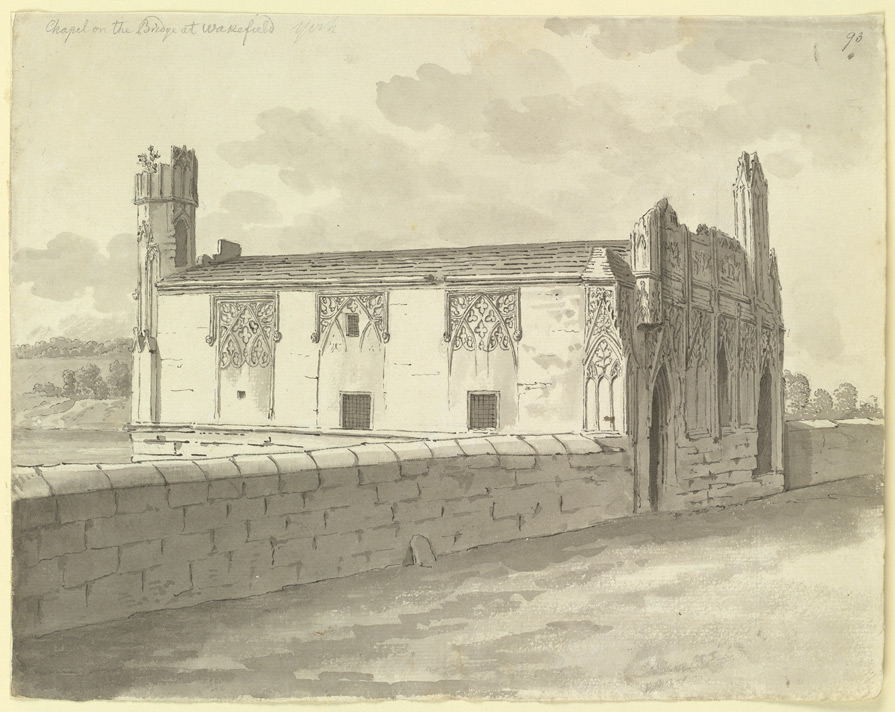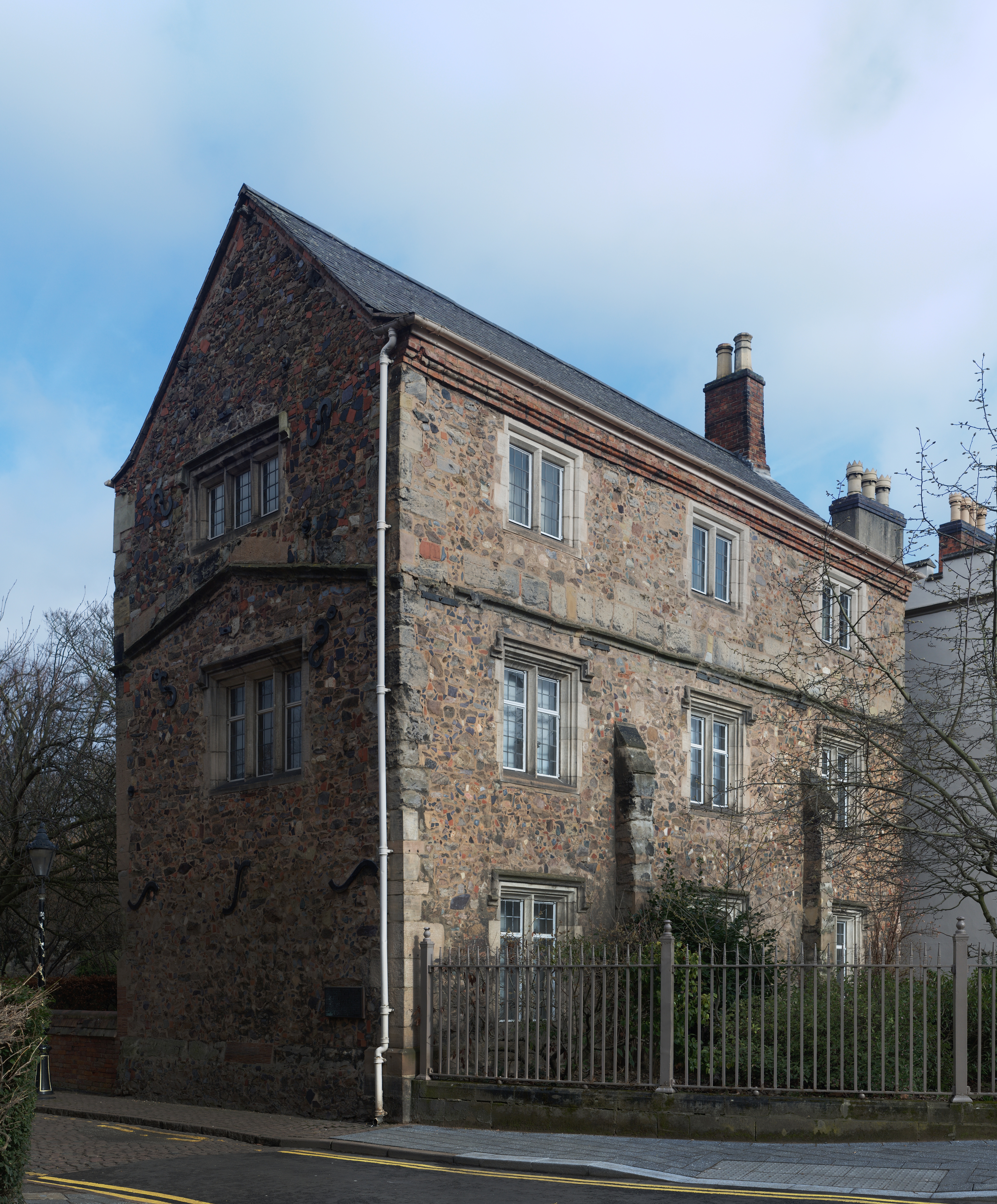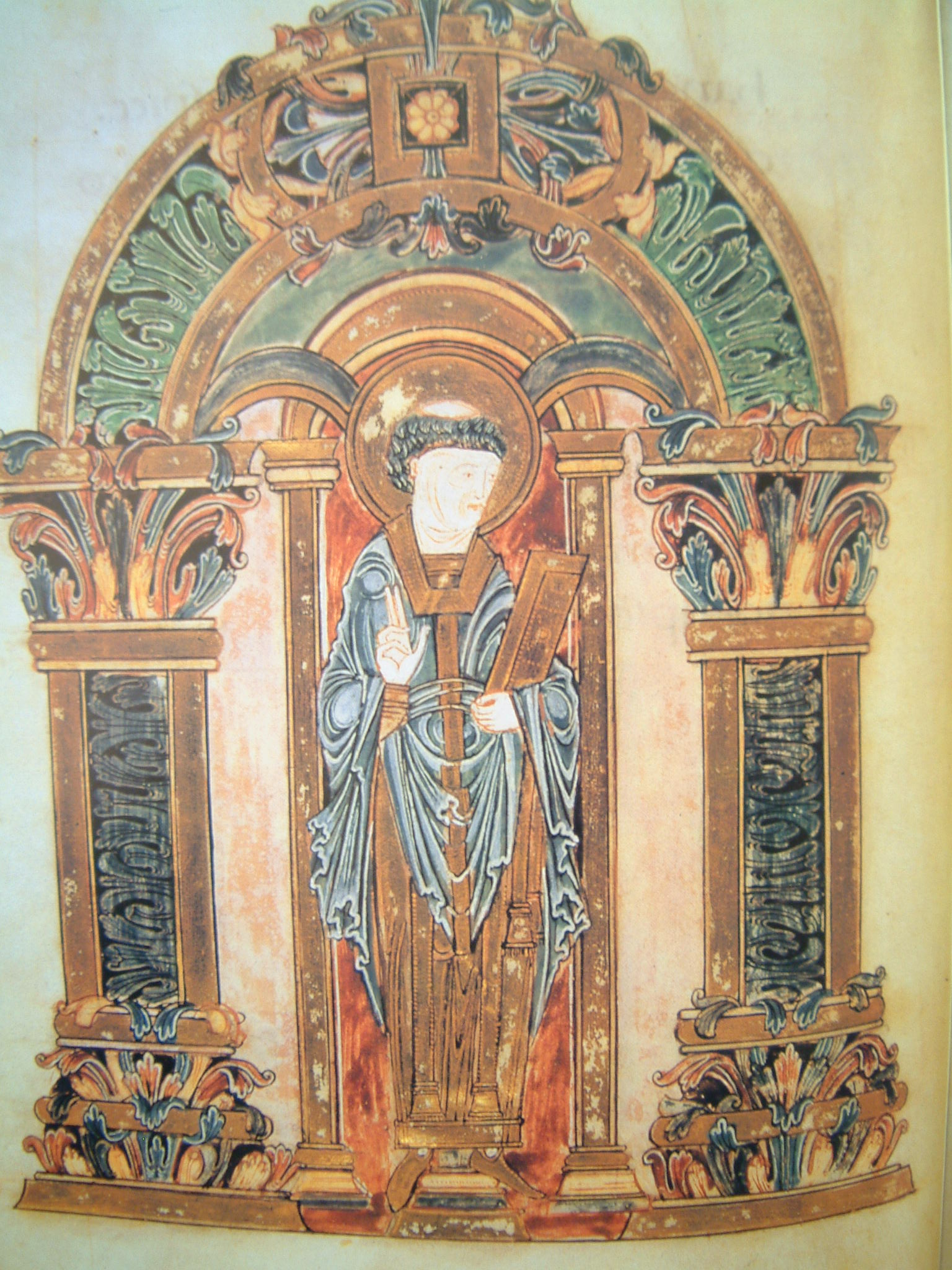|
Chantry Chapel Of St Mary The Virgin, Wakefield
The Chantry Chapel of St Mary the Virgin is a chantry chapel in Wakefield, West Yorkshire, England, and is designated a Grade I Listed building by English Heritage. It is located south of the city centre on the medieval bridge over the River Calder. It is the only survivor of four chantries in Wakefield and the oldest and most ornate of the surviving bridge chapels in England. Others are at St Ives (Cambridgeshire), Rotherham, Derby and Bradford-on-Avon. The chapel has had three west fronts, the original medieval façade having been removed to Kettlethorpe Hall in 1832. The medieval bridge is a scheduled ancient monument. History Wakefield had four chantry chapels, three of which dated from the 13th century. They were built outside the medieval town on the roads leading to Leeds, Dewsbury, York and Doncaster. The Chantry of St John the Baptist was on Northgate, the road to Leeds, where Wakefield Grammar School stands today. The Chapel of St Mary Magdalene was on Westgate where ... [...More Info...] [...Related Items...] OR: [Wikipedia] [Google] [Baidu] |
Wakefield
Wakefield is a cathedral city in West Yorkshire, England located on the River Calder. The city had a population of 99,251 in the 2011 census.https://www.nomisweb.co.uk/census/2011/ks101ew Census 2011 table KS101EW Usual resident population, West Yorkshire – Wakefield BUASD, code E35000474 The city is the administrative centre of the wider City of Wakefield metropolitan district, which had a population of , the most populous district in England. It is part of the West Yorkshire Built-up Area and the Yorkshire and The Humber region. In 1888, it was one of the last group of towns to gain city status due to having a cathedral. The city has a town hall and county hall, as the former administrative centre of the city's county borough and metropolitan borough as well as county town to both the West Riding of Yorkshire and West Yorkshire, respectively. The Battle of Wakefield took place in the Wars of the Roses, and the city was a Royalist stronghold in the Civil War ... [...More Info...] [...Related Items...] OR: [Wikipedia] [Google] [Baidu] |
York
York is a cathedral city with Roman Britain, Roman origins, sited at the confluence of the rivers River Ouse, Yorkshire, Ouse and River Foss, Foss in North Yorkshire, England. It is the historic county town of Yorkshire. The city has many historic buildings and other structures, such as a York Minster, minster, York Castle, castle, and York city walls, city walls. It is the largest settlement and the administrative centre of the wider City of York district. The city was founded under the name of Eboracum in 71 AD. It then became the capital of the Roman province of Britannia Inferior, and later of the kingdoms of Deira, Northumbria, and Jórvík, Scandinavian York. In the Middle Ages, it became the Province of York, northern England ecclesiastical province's centre, and grew as a wool-trading centre. In the 19th century, it became a major railway network hub and confectionery manufacturing centre. During the Second World War, part of the Baedeker Blitz bombed the city; it ... [...More Info...] [...Related Items...] OR: [Wikipedia] [Google] [Baidu] |
Victorian Restoration
The Victorian restoration was the widespread and extensive refurbishment and rebuilding of Church of England churches and cathedrals that took place in England and Wales during the 19th-century reign of Queen Victoria. It was not the same process as is understood today by the term building restoration. Against a background of poorly maintained church buildings, a reaction against the Puritan ethic manifested in the Gothic Revival, and a shortage of churches where they were needed in cities, the Cambridge Camden Society and the Oxford Movement advocated a return to a more medieval attitude to churchgoing. The change was embraced by the Church of England which saw it as a means of reversing the decline in church attendance. The principle was to "restore" a church to how it might have looked during the " Decorated" style of architecture which existed between 1260 and 1360, and many famous architects such as George Gilbert Scott and Ewan Christian enthusiastically accepted c ... [...More Info...] [...Related Items...] OR: [Wikipedia] [Google] [Baidu] |
Oxford Movement
The Oxford Movement was a movement of high church members of the Church of England which began in the 1830s and eventually developed into Anglo-Catholicism. The movement, whose original devotees were mostly associated with the University of Oxford, argued for the reinstatement of some older Christian traditions of faith and their inclusion into Anglican liturgy and theology. They thought of Anglicanism as one of three branches of the " one, holy, catholic, and apostolic" Christian church. Many key participants subsequently converted to Roman Catholicism. The movement's philosophy was known as Tractarianism after its series of publications, the '' Tracts for the Times'', published from 1833 to 1841. Tractarians were also disparagingly referred to as "Newmanites" (before 1845) and "Puseyites" (after 1845) after two prominent Tractarians, John Henry Newman and Edward Bouverie Pusey. Other well-known Tractarians included John Keble, Charles Marriott, Richard Froude, Robert ... [...More Info...] [...Related Items...] OR: [Wikipedia] [Google] [Baidu] |
Chantry Chapel, Wakefield Bridge (7568910296)
A chantry is an ecclesiastical term that may have either of two related meanings: # a chantry service, a Christian liturgy of prayers for the dead, which historically was an obiit, or # a chantry chapel, a building on private land, or an area in a parish church or cathedral reserved for the performance of the "chantry duties". In the Medieval Era through to the Age of Enlightenment it was commonly believed such liturgies might help atone for misdeeds and assist the soul to obtain eternal peace. Etymology The word "chantry" derives from Old French ''chanter'' and from the Latin ''cantare'' (to sing). Its medieval derivative ''cantaria'' means "licence to sing mass". The French term for this commemorative institution is ''chapellenie'' (chaplaincy). Overview Liturgy for the dead Firstly, a chantry could mean the prayers and liturgy in the Christian church for the benefit of the dead, as part of the search for atonement for sins committed during their lives. It might include the ma ... [...More Info...] [...Related Items...] OR: [Wikipedia] [Google] [Baidu] |
Watercolour
Watercolor (American English) or watercolour (British English; see spelling differences), also ''aquarelle'' (; from Italian diminutive of Latin ''aqua'' "water"), is a painting method”Watercolor may be as old as art itself, going back to the Stone Age when early ancestors combined earth and charcoal with water to create the first wet-on-dry picture on a cave wall." London, Vladimir. The Book on Watercolor (p. 19). in which the paints are made of pigments suspended in a water-based solution. ''Watercolor'' refers to both the medium and the resulting artwork. Aquarelles painted with water-soluble colored ink instead of modern water colors are called ''aquarellum atramento'' (Latin for "aquarelle made with ink") by experts. However, this term has now tended to pass out of use. The conventional and most common ''support''—material to which the paint is applied—for watercolor paintings is watercolor paper. Other supports or substrates include stone, ivory, silk, reed, papyru ... [...More Info...] [...Related Items...] OR: [Wikipedia] [Google] [Baidu] |
Chantry
A chantry is an ecclesiastical term that may have either of two related meanings: # a chantry service, a Christian liturgy of prayers for the dead, which historically was an obiit, or # a chantry chapel, a building on private land, or an area in a parish church or cathedral reserved for the performance of the "chantry duties". In the Medieval Era through to the Age of Enlightenment it was commonly believed such liturgies might help atone for misdeeds and assist the soul to obtain eternal peace. Etymology The word "chantry" derives from Old French ''chanter'' and from the Latin ''cantare'' (to sing). Its medieval derivative ''cantaria'' means "licence to sing mass". The French term for this commemorative institution is ''chapellenie'' (chaplaincy). Overview Liturgy for the dead Firstly, a chantry could mean the prayers and liturgy in the Christian church for the benefit of the dead, as part of the search for atonement for sins committed during their lives. It might include the ... [...More Info...] [...Related Items...] OR: [Wikipedia] [Google] [Baidu] |
Reformation
The Reformation (alternatively named the Protestant Reformation or the European Reformation) was a major movement within Western Christianity in 16th-century Europe that posed a religious and political challenge to the Catholic Church and in particular to papal authority, arising from what were perceived to be Criticism of the Catholic Church, errors, abuses, and discrepancies by the Catholic Church. The Reformation was the start of Protestantism and the split of the Western Church into Protestantism and what is now the Roman Catholic Church. It is also considered to be one of the events that signified the end of the Middle Ages and the beginning of the early modern period in Europe.Davies ''Europe'' pp. 291–293 Prior to Martin Luther, there were many Proto-Protestantism, earlier reform movements. Although the Reformation is usually considered to have started with the publication of the ''Ninety-five Theses'' by Martin Luther in 1517, he was not excommunicated by Pope Leo ... [...More Info...] [...Related Items...] OR: [Wikipedia] [Google] [Baidu] |
Edmund, Earl Of Rutland
Edmund, Earl of Rutland (17 May 1443 – 30 December 1460) was the fourth child and second surviving son of Richard Plantagenet, 3rd Duke of York, and Cecily Neville. He was a younger brother of Edward, Earl of March, the future King Edward IV who came to the throne in 1461, the year after Edmund's death. He was born in Rouen, then the capital of English-occupied France and his father held the office of Lieutenant of France. He was killed at the age of 17 either during or shortly after the Battle of Wakefield, during the Wars of the Roses. He was created Earl of Rutland by King Henry VI probably at some time before 1454, aged about 11, as Edmund and his elder brother Edward signed a letter to their father on 14 June 1454 as "E. Rutland" and "E. Marche". No record of the creation survives. Lord Chancellor of Ireland In 1451, Edmund's father, who held the title of Lord Lieutenant of Ireland, appointed Edmund as Lord Chancellor of Ireland. As Edmund was underage, the duties of ... [...More Info...] [...Related Items...] OR: [Wikipedia] [Google] [Baidu] |
Battle Of Wakefield
The Battle of Wakefield took place in Sandal Magna near Wakefield in northern England, on 30 December 1460. It was a major battle of the Wars of the Roses. The opposing forces were an army led by nobles loyal to the captive King Henry VI of the House of Lancaster and his Queen Margaret of Anjou on one side, and the army of Richard, Duke of York, the rival claimant to the throne, on the other. For several years before the battle, the Duke of York had become increasingly opposed to the weak King Henry's court. After open warfare broke out between the factions and Henry became his prisoner, he laid claim to the throne, but lacked sufficient support. Instead, in an agreement known as the Act of Accord, he was made Henry's heir to the throne, displacing from the succession Henry's and Margaret's 7-year-old son Edward, Prince of Wales. Margaret of Anjou and several prominent nobles were irreconcilably opposed to this accord, and massed their armies in the north. Richard of Yo ... [...More Info...] [...Related Items...] OR: [Wikipedia] [Google] [Baidu] |
Ford (crossing)
A ford is a shallow place with good footing where a river or stream may be crossed by wading, or inside a vehicle getting its wheels wet. A ford may occur naturally or be constructed. Fords may be impassable during high water. A low-water crossing is a low bridge that allows crossing over a river or stream when water is low but may be treated as a ford when the river is high and water covers the crossing. Description A ford is a much cheaper form of river crossing than a bridge, and it can transport much more weight than a bridge, but it may become impassable after heavy rain or during flood conditions. A ford is therefore normally only suitable for very minor roads (and for paths intended for walkers and horse riders etc.). Most modern fords are usually shallow enough to be crossed by cars and other wheeled or tracked vehicles (a process known as "fording"). Fords may be accompanied by stepping stones for pedestrians. The United Kingdom has more than 2,000 fords, and mos ... [...More Info...] [...Related Items...] OR: [Wikipedia] [Google] [Baidu] |
St Swithun
Swithun (or Swithin; ang, Swīþhūn; la, Swithunus; died 863 AD) was an Anglo-Saxon bishop of Winchester and subsequently patron saint of Winchester Cathedral. His historical importance as bishop is overshadowed by his reputation for posthumous miracle-working. According to tradition, if it rains on Saint Swithun's bridge (Winchester) on his feast day (15 July) it will continue for forty days. Biography St. Swithun was Bishop of Winchester from his consecration on 30 October 852 until his death on 2 July 863. However, he is scarcely mentioned in any document of his own time. His death is entered in the Canterbury manuscript of the ''Anglo-Saxon Chronicle'' (MS F) under the year 861. He is recorded as a witness to nine charters, the earliest of which (S 308) is dated 854. More than a hundred years later, when Dunstan and Æthelwold of Winchester were inaugurating their church reform, Swithun was adopted as patron of the restored church at Winchester, formerly dedicated ... [...More Info...] [...Related Items...] OR: [Wikipedia] [Google] [Baidu] |




.jpg)


.jpg)

